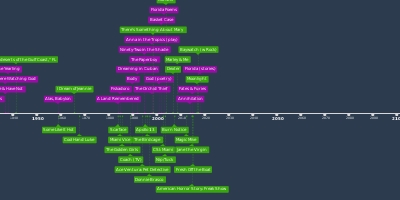17 сент 1935 г. - Magic realism
Описание:
Literary movement in which magical elements appear in otherwise realistic circumstances. Most often associated with the Latin American literary boom of the 20th century.Characteristics
The extent to which the characteristics below apply to a given magic realist text varies. Every text is different and employs a smattering of the qualities listed here. However, they accurately portray what one might expect from a magic realist text.
Fantastical elements
Magical realism portrays fantastical events in an otherwise realistic tone. It brings fables, folk tales, and myths into contemporary social relevance. Fantasy traits given to characters, such as levitation, telepathy, and telekinesis, help to encompass modern political realities that can be phantasmagorical.[8]
Real-world setting
The existence of fantasy elements in the real world provides the basis for magical realism. Writers do not invent new worlds but reveal the magical in this world, as was done by Gabriel García Márquez who wrote the seminal work of the style, One Hundred Years of Solitude.[9] In the world of magical realism, the supernatural realm blends with the natural, familiar world.[10]
Authorial reticence
Authorial reticence is the "deliberate withholding of information and explanations about the disconcerting fictitious world".[11] The narrator is indifferent, a characteristic enhanced by this absence of explanation of fantastic events; the story proceeds with "logical precision" as if nothing extraordinary had taken place.[12][13] Magical events are presented as ordinary occurrences; therefore, the reader accepts the marvelous as normal and common.[14] Explaining the supernatural world or presenting it as extraordinary would immediately reduce its legitimacy relative to the natural world. The reader would consequently disregard the supernatural as false testimony.
Plenitude
In his essay "The Baroque and the Marvelous Real", Cuban writer Alejo Carpentier defined the baroque by a lack of emptiness, a departure from structure or rules, and an "extraordinary" abundance (plenitude) of disorienting detail (citing Mondrian as its opposite). From this angle, Carpentier views the baroque as a layering of elements, which translates easily into the post-colonial or transcultural Latin American atmosphere that he emphasizes in The Kingdom of this World.[15] "America, a continent of symbiosis, mutations... mestizaje, engenders the baroque",[16] made explicit by elaborate Aztec temples and associative Nahuatl poetry. These mixing ethnicities grow together with the American baroque; the space in between is where the "marvelous real" is seen. Marvelous: not meaning beautiful and pleasant, but extraordinary, strange, and excellent. Such a complex system of layering—encompassed in the Latin American "boom" novel, such as One Hundred Years of Solitude—aims towards "translating the scope of America".[17]
Hybridity
Magical realism plot lines characteristically employ hybrid multiple planes of reality that take place in "inharmonious arenas of such opposites as urban and rural, and Western and indigenous".[18][19]
Metafiction
Main article: Metafiction
This trait centers on the reader's role in literature. With its multiple realities and specific reference to the reader's world, it explores the impact fiction has on reality, reality on fiction and the reader's role in between; as such, it is well suited for drawing attention to social or political criticism. Furthermore, it is the tool paramount in the execution of a related and major magic realist phenomenon: textualization. This term defines two conditions—first, where a fictitious reader enters the story within a story while reading it, making them self-conscious of their status as readers—and secondly, where the textual world enters into the reader's (real) world. Good sense would negate this process but "magic" is the flexible convention that allows it.[20]
Heightened awareness of mystery
Something that most critics agree on is this major theme. Magic realist literature tends to read at an intensified level. Taking One Hundred Years of Solitude, the reader must let go of preexisting ties to conventional exposition, plot advancement, linear time structure, scientific reason, etc., to strive for a state of heightened awareness of life's connectedness or hidden meanings. Luis Leal articulates this feeling as "to seize the mystery that breathes behind things",[21] and supports the claim by saying a writer must heighten his senses to the point of "estado limite" (translated as "limit state" or "extreme") in order to realize all levels of reality, most importantly that of mystery.[22]
Political critique
Magic realism contains an "implicit criticism of society, particularly the elite".[23] Especially with regard to Latin America, the style breaks from the inarguable discourse of "privileged centers of literature".[24] This is a mode primarily about and for "ex-centrics": the geographically, socially and economically marginalized. Therefore, magic realism's "alternative world" works to correct the reality of established viewpoints (like realism, naturalism, modernism). Magic realist texts, under this logic, are subversive texts, revolutionary against socially dominant forces. Alternatively, the socially dominant may implement magical realism to disassociate themselves from their "power discourse".[25] Theo D’haen calls this change in perspective "decentering".
In his review of Gabriel Garcia Márquez' novel Chronicle of a Death Foretold, Salman Rushdie argues that the formal experiment of magic realism allows political ideas to be expressed in ways which might not be possible through more established literary forms:[26]
"El realismo magical", magic realism, at least as practised by Márquez, is a development out of Surrealism that expresses a genuinely "Third World" consciousness. It deals with what Naipaul has called "half-made" societies, in which the impossibly old struggles against the appallingly new, in which public corruptions and private anguishes are somehow more garish and extreme than they ever get in the so-called "North", where centuries of wealth and power have formed thick layers over the surface of what's really going on. In the works of Márquez, as in the world he describes, impossible things happen constantly, and quite plausibly, out in the open under the midday sun.[27]
Добавлено на ленту времени:
Дата:
17 сент 1935 г.
Сейчас
~ 90 г назад
